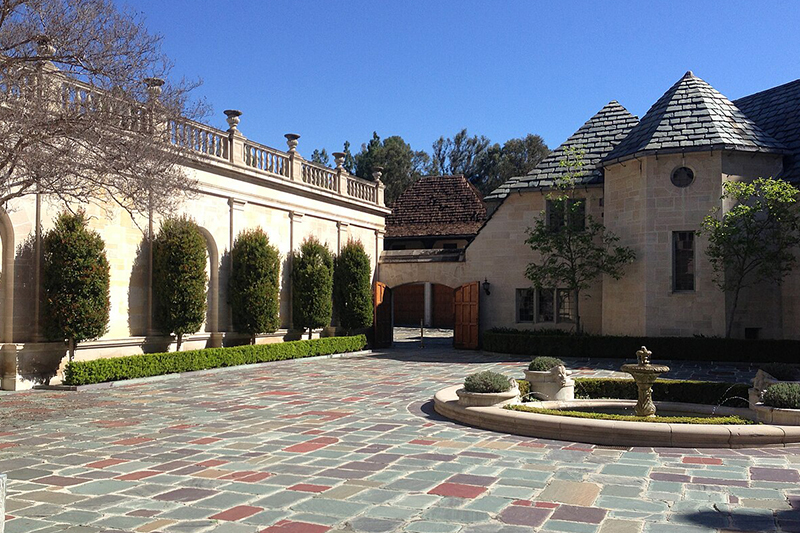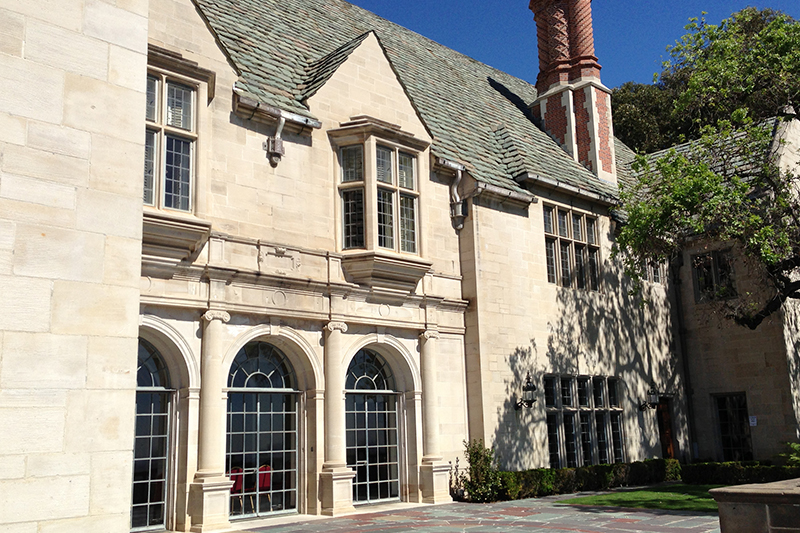Greystone Mansion and the cultural legacy of Beverly Hills

Once a private estate, the Greystone Mansion is now one of Beverly Hills’ most enduring landmarks.
There’s a distinct quiet that settles over Greystone Mansion in Beverly Hills. It isn’t just the stillness of its gardens or the weight of its stone facade. It’s the presence of something lasting.
Many know the estate through films and tours, but its significance runs deeper. It represents the foundation of Beverly Hills as a place built with purpose, not pretense. It shaped the identity of the city before it became a symbol of global luxury.
In the context of Beverly Hills luxury real estate, Greystone remains a touchstone. Its very presence elevates the surrounding neighborhood, setting a tone that newer properties quietly follow. Buyers drawn to history and design often find their benchmark here.
Table of Contents:
THE ORIGINS OF GREYSTONE MANSION
Every landmark has a beginning, but few start with the scale and symbolism of Greystone. Built during a period of rapid growth and ambition, the property reflects the rise of one of California’s most influential families and the early vision that helped shape Beverly Hills into a center of wealth, architecture, and cultural identity.
A home born from industry
Construction of the Greystone Mansion in Beverly Hills began in 1927, commissioned by oil heir Edward “Ned” Doheny Jr. as a gift from his father, Edward L. Doheny. At the time, the elder Doheny was one of the wealthiest men in America. His fortune, forged through pioneering oil exploration in California and Mexico, funded what became one of Los Angeles’ most expensive private residences. The reported $3 million cost—equivalent to over $55 million today—was extraordinary for its time.
The Greystone Mansion’s Tudor Revival style—designed by architect Gordon B. Kaufmann—was rare on the West Coast. Spanning more than 18 acres, the estate includes a 46,000-square-foot main residence with 55 rooms. Constructed with Indiana limestone and finished with hand-carved wood paneling, imported marble, and leaded-glass windows, it was crafted to endure.
Yet even homes built to last are not immune to human tragedy. Just months after the family moved in, Ned Doheny was found dead inside the mansion in 1929—a case that remains unresolved to this day. The property stayed with the family for several years, was sold in the 1950s, and was ultimately acquired by the City of Beverly Hills in 1965.
A new era of estate living
Greystone marked the arrival of Beverly Hills as an elite residential enclave. At the time of its construction, the estate introduced a scale and level of craftsmanship rarely seen in Southern California. Oil barons, studio heads, and industrialists flocked to the hills above Sunset and away from older Los Angeles enclaves. The neighborhood where Greystone is located—Trousdale Estates—is now one of the most sought-after addresses in all of Los Angeles.
ARCHITECTURE THAT SHAPED A LEGACY
Every element of the Greystone Mansion was built for permanence. From its exterior to its formal English-inspired layout, every part of the estate reflects a level of craftsmanship and intent rarely seen in early Los Angeles estates. Nearly a century later, its original structure and design remain largely intact.
The creative mind behind the project
The architectural identity of the Greystone Mansion in Beverly Hills is rooted in architect Gordon B. Kaufmann’s mastery of scale and proportion. Educated at the London Polytechnic and trained in the Beaux-Arts tradition, Kaufmann brought a European sensibility to California’s growing architectural landscape.
By the time he was commissioned for Greystone, Kaufmann had already gained recognition for his refined approach to grand estates and institutional projects. His interpretation of Tudor Revival at Greystone—marked by steep gables, coursed limestone, and symmetrical massing—married Old World formality with California’s emerging taste for privacy, light, and indoor-oudoor flow.
Greystone’s built form
The Greystone’s exterior, clad in hand-hewn limestone and Indiana stone, features steeply pitched gables, decorative chimneys, and a layout that unfolds into terraces and interior courtyards.
Inside, the craftsmanship is immediate. The entrance hall soars into a vaulted ceiling with intricately carved woodwork. Leaded-glass windows diffuse the light, softening even the home’s most formal spaces. Arched openings and paneled doors link the rooms in a natural rhythm, creating a sense of movement.
Notable features and amenities include:
- Double-height grand staircase
- Full-size bowling alley
- Hidden passageways and servant corridors
- Library and study with wood-paneled interiors
- Formal drawing and dining rooms
- Tiered fountains and formal gardens
- Tree-lined pathways and sweeping lawns
- Panoramic views of LA and the Pacific from upper elevations

Designed in the Tudor Revival style, the estate blends formality and craftsmanship.
Out in the gardens
Tree-lined pathways, tiered fountains, and lawns activate the estate’s 18+ acres. Designed by German-American landscape architect Paul Thiene in 1926, the grounds were laid out on three formal terraces, blending Italian and English influences through stone staircases, reflective pools, and Gothic-neoclassical detailing.
Thiene, who had worked under Frederick Law Olmsted Jr. and led the landscape design for the Panama-California Exposition, brought a mastery of water and structure to Greystone. He incorporated an 80-foot cascading waterfall, two ornamental lakes, and greenhouse—a horticultural feat that transformed dry Southern California hillside into a dramatic environment.
Plantings such as clipped boxwood, crape myrtle allées, camellias, lavender, and white roses form elegant, geometric masses that echo the mansion’s symmetry. Stone carved fountains and framed viewlines complete the composition, reinforcing the mansion’s architectural intent and offering scenes of quiet retreat.
GREYSTONE ON SCREEN: A CINEMATIC ICON
Greystone’s cultural impact is perhaps most widely felt through film and television. For decades, its rooms, gardens, and stone façades have served as recognizable backdrops, seen by millions before ever being visited in person.
A familiar face in film and television
Few properties have shaped public imagination the way the Greystone Mansion in Beverly Hills has. With more than a hundred screen appearances, the estate has served as a visual anchor for stories set in wealth, mystery, and power. Its presence in film and television has elevated it from private residence to cultural symbol.
Some sources suggest that Greystone first made its appearance on screen in the 1929 silent short film Small Talk. The mansion’s emergence as a prominent filming location, however, can be traced back to the 1940s and 1960s. Two larger Hollywood productions (The Ghost and Mrs. Muir and The Loved One) were shot in Greystone.
With its vast interiors, secluded setting, and architecture, Greystone quickly became a favorite among location scouts. Its adaptability—able to portray European estates, East Coast institutions, or imagined worlds—offered filmmakers a ready-made canvas. Word of its cinematic versatility spread, and over time, it became an essential part of Los Angeles’ production landscape.
Today, Greystone stands among the most filmed private estates in the country. Some of the more contemporary film productions that made use of the mansion include The Big Lebowski (1998), There Will Be Blood (2007), The Social Network (2010), X-Men (2000), and Death Becomes Her (1992).
Designers, directors, and the visual legacy
The cinematic reach of the Greystone Mansion in Beverly Hills has added tangible value to the surrounding area. It has become a core part of the neighborhood’s identity, adding both symbolic and tangible appeal.
For many buyers, the area around Greystone represents the authentic Beverly Hills lifestyle. Even those who don’t know the mansion by name often recognize its stone staircases or manicured courtyards from films they’ve seen, creating a sense of familiarity and prestige before they ever arrive. This connection adds emotional value that translates directly to desirability.
The estate’s role in ongoing productions—typically five or more per year—brings another layer of benefit. Film permit revenue helps fund the property’s maintenance and restoration, allowing Greystone to preserve its character without taxpayer burden. That self-sustaining model adds cachet to the Beverly Hills luxury real estate, signaling not just beauty, but smart stewardship.
All that said, there is no official study that isolates Greystone’s direct impact on real estate prices. Broader market patterns, however, are revealing. Properties near cultural landmarks in legacy markets like Beverly Hills often command a premium, typically 5-15% more than comparable homes elsewhere.
In Greystone’s case, its enduring media presence supports mid-to-high single digit value boosts, especially when listings emphasize proximity with phrases like “Greystone-adjacent,” “cinematic enclave,” or “historic landmark views.” For luxury buyers seeking more than just location, this context matters. Greystone offers scale and seclusion, but also a story. And in a market where perception is value, that story continues to pay dividends.
💡 Did you know?Greystone Mansion has appeared in over 100 productions, making it one of the most filmed private estates in California. These productions include The Prestige (2006), The Princess Diaries (2001), The Witches of Eastwick (1987), In Time (2011), Spider-Man (2002), The Great Gatsby (2013), Ocean’s Eleven (2001), and Mission: Impossible III (2006). |

Greystone’s gardens heavily feature water.
A PUBLIC TREASURE: HOW GREYSTONE SERVES THE COMMUNITY TODAY
What began as a private residence now serves as a shared landmark. Greystone Mansion offers a rare access to a space with deep historical and civic value. Through thoughtful stewardship, the estate has become a cultural venue, public garden, and civic gathering place.
A civic landmark with cultural reach
The Greystone Mansion in Beverly Hills is currently open to visitors, artists, and community groups throughout the year. This rare level of access allows residents and guests to engage with one of the city’s most iconic properties in a meaningful, personal way.
The Greystone is open daily from 10 AM to 5 PM; the formal gardens are free to the public and offer shaded walkways, terraced overlooks, and quiet seating areas. Parking is also free. The interiors, however, are not open for drop-in visits as they regularly host a rotating calendar of private receptions, guided architectural tours and self-guided tours, classical concerts, and public events throughout the year.
Events at Greystone
Each year, the Greystone estate plays host to a curated selection of events that celebrate its architectural grandeur, Hollywood heritage, and place within Beverly Hills’ public life. These events and festivals include:
- Music in the Mansion, a long-running concert series that brings emerging and international classical artists to perform in Greystone’s paneled drawing rooms. The intimate setting and exceptional acoustics make it one of Beverly Hills’ most sought-after chamber music venues. This year’s concerts, which took place early in 2025, featured the winners of the 2024 Beverly Hills National Auditions.
- Greystone in the Movies, an occasional film series that celebrates Greystone’s cinematic legacy with screenings of notable productions filmed on the estate grounds. Held outdoors or in designated interior rooms, the program often includes director Q&As, behind-the-scenes commentary, or guided tours that trace scenes to their real locations. It’s a rare chance for guests to experience the mansion as both setting and star.
Upcoming screenings: Star Trek Into Darkness (July 24, Thursday) | National Treasure Book of Secrets (August 14, Thursday) | Purchase tickets here
- Holiday events at Greystone are expected every December and feature festive décor, films, and seasonal tours. Last year, the line-up included outdoor film screenings of It’s A Wonderful Life and The Holiday, WineMusic at Greystone featuring The Nutcracker Suite, holiday editions of the Inside the Mansion self-guided tours, and the Greystone Gala.
A landmark that shapes the city’s identity
As one of the few publicly owned estates of its scale in the country, Greystone Mansion represents a rare civic asset. The estate appears regularly in official tourism materials, serves as a film site for international productions, and draws tens of thousands of visitors annually. Its presence affirms Beverly Hills’ reputation not only for its luxury, but for preservation and cultural depth.
Greystone is a reflection of the city’s values. It signals a community that invests in beauty, public access, and heritage. For those considering life in Beverly Hills, the estate stands as proof that preservation and cultural depth are part of the long-term vision.
READY TO DISCOVER YOUR OWN PIECE OF BEVERLY HILLS HISTORY?
Greystone may be the first of its kind, but it’s also not the last. Since it was built, various other luxury properties with stunning architecture and design—as well as histories to tell—have cropped up all over the city and Los Angeles County. And if you would like to add a legacy property to your real estate portfolio, you have come to the right place.
I’m Joyce Rey, and for decades, I’ve guided discerning buyers to some of Beverly Hills‘ most prominent and storied properties: Pickfair, Owlwood, and the Chartwell Estate, just to name a few. I’d be delighted to do the same for you.
Contact me at 310.291.6646 or send a message to explore your options in Beverly Hills luxury real estate.

Browse our latest news and updates below

![[ai_client_name]](https://joycerey.com/app/themes/joycereycom_2024/assets/images/site-logo-white.svg)
